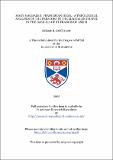Files in this item
Mary Magdalen, Franciscan ideal : a theological analysis of the frescoes in the Magdalen Chapel in the Basilica of St Francis of Assisi
Item metadata
| dc.contributor.author | Lott, Stefanie B. | |
| dc.coverage.spatial | iii, 140 p. | en_US |
| dc.date.accessioned | 2018-05-17T12:49:11Z | |
| dc.date.available | 2018-05-17T12:49:11Z | |
| dc.date.issued | 2005 | |
| dc.identifier.uri | https://hdl.handle.net/10023/13378 | |
| dc.description.abstract | In the small town of Assisi in Italy, there is a chapel dedicated to Mary Magdalen. This well known figure from the New Testament Gospels is an anomaly. To many she is the prostitute turned disciple: to others she is a key witness to the resurrection. The frescoes show this Magdalen, but they also show her in strange scenes not found in the Bible. The Gospels tell us that Mary Magdalen was with Jesus in his ministry, at the crucifixion and at the resurrection. Early church fathers picked up on this and linked her with other unnamed women in the Gospels to develop an ideal model of discipleship. From there, legends developed this conflated Magdalen into the embodiment of chastity, penitence and devotion. As such, she became the focus of one of the greatest cult followings of the Middle Ages and her relics where at the heart of the fourth most visited pilgrimage site in Christendom. In the thirteenth century, a young man, Francis of Assisi helped to revolutionise and revive the life of the Church by his personal example of poverty, benevolence and pure devotion; virtues embodied by the Magdalen. It is then understandable that a chapel dedicated to her should be found in the basilica built to honour Francis. However, the reasons behind the chapel's existence and location also have a great deal to do with the power and influence of the secular (Angevin) and religious establishment of the time as well as the controversies burgeoning within the Franciscan Order including the roles of second order women and the influence of the two factions of Franciscanism, Spirituals and Conventuals. Finally, it must not be forgotten that the Magdalen chapel, a means of theological and political dogma, was also a very tangible and real visual sermon to the masses of pilgrims who flocked to visit the shrine of Francis. This project is an attempt to uncover the identity of the woman in and the meaning of the Magdalen Chapel in the Lower Church of the Basilica of St Francis in Assisi. | en_US |
| dc.language.iso | en | en_US |
| dc.publisher | University of St Andrews | |
| dc.subject.lcc | BS2485.L7 | |
| dc.subject.lcsh | Mary, Magdalene, Saint--Art | en |
| dc.subject.lcsh | San Francesco (Church : Assisi, Italy) | en |
| dc.subject.lcsh | Mary, Magdalene, Saint--Cult | en |
| dc.subject.lcsh | Assisi (Italy)--Church history | en |
| dc.subject.lcsh | Franciscans--Italy--Assisi | en |
| dc.subject.lcsh | Mural painting and decoration--Italy--Assisi | en |
| dc.title | Mary Magdalen, Franciscan ideal : a theological analysis of the frescoes in the Magdalen Chapel in the Basilica of St Francis of Assisi | en_US |
| dc.type | Thesis | en_US |
| dc.type.qualificationlevel | Doctoral | en_US |
| dc.type.qualificationname | MPhil Master of Philosophy | en |
| dc.publisher.institution | The University of St Andrews | en_US |
This item appears in the following Collection(s)
Items in the St Andrews Research Repository are protected by copyright, with all rights reserved, unless otherwise indicated.

